Progress in Managing Weeds, Mollusks and Vertebrates
by Cheryl Wilen
Insects, mites, pathogens — these plant pests often get first billing when talking about advances in research and implementation of integrated pest management (IPM). However, agricultural systems, including ornamental plant production, are beset with many other classes of pests including weeds, mollusks (snails and slugs) and vertebrate animals. These pests probably are not as prominent on a grower’s radar as arthropods or pathogens because they may not be causing direct damage to crops. Nevertheless, unless managed appropriately, they will affect the grower’s bottom line.
Weed Management
Weed management consistently ranks as one of the highest pest management expenses in ornamental crop production. This may be due to the variety of crops grown at a single operation and the paucity of herbicides that can be used on more than a few species. Additionally, only a small number of herbicides are available to control emerged weeds; therefore cultivation and hand weeding are frequently employed. One advance in the management of weeds is the use of mulches for container production. Mulches can be used when herbicides are unavailable to reduce the cost of hand labor or as a supplement to chemical control. While application is more labor intensive than herbicides, research conducted by myself and others have shown that the length of time that mulches are effective in controlling weeds is equal to many herbicides and may even be longer. However, the size of the chips must be matched to the container size: chips should not be larger than ½ inch for 1-gallon containers, but slightly larger chips can be used in 5-gallon and larger containers.
In field production, the most important weed management problem facing the industry has been the phase out of methyl bromide. Research to address this issue is still underway and there has been some progress. Solarization, steam, and soil additives such as mustard seed meal are being tested and implemented as fumigant alternatives for both field and greenhouse-grown crops.
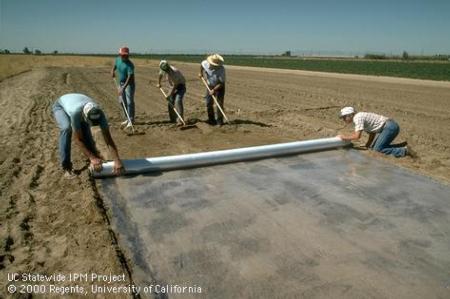
Soil heating through solarization is an effective method for managing some weeds and soil-dwelling plant pathogens including nematodes. Photo by Jack Kelly Clark, courtesy of UC IPM.
Additionally, a number of new herbicides, including those with novel modes of action, have been introduced or will soon be available for nursery crops, such as dimethenamid-P (active ingredient in Freehand, Tower) and indaziflam (a.i. in Specticle, Marengo). Also on the horizon, but still being tested, are bioherbicides containing iron HEDTA — which selectively control some broadleaf weeds — and a new product derived from bacteria that is a non-selective preemergent herbicide (Marrone Bio Innovations).
Mollusk Management
Snails and slugs often cause direct damage to nursery crops but more importantly can limit where a grower can ship. Mollusks and their eggs in container media may not be detected until the shipment arrives at the final destination. When found, the result can be crop destruction, return, or — in a worst case scenario — restriction of shipment to other states and similar restrictions imposed on other growers through quarantine regulations. In California and other states, we have been studying how newly registered materials such as ferric sodium EDTA can be used in snail control as well as looking at natural products, including essential plant oils as repellants. A system of preventative methods combined with inspection, monitoring and appropriate timing of controls will be the most effective IPM program for mollusks, as with many pests.
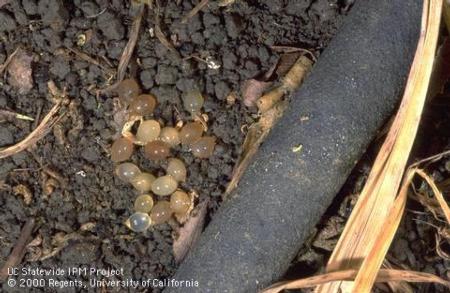
European brown snail eggs are laid in soil or potting media in groups of about 5 to 50. Eggs are bright white initially and become darker brown as the embryo develops. Photo by Jack Kelly Clark, courtesy of UC IPM.
Vertebrate Management
Rabbits, birds and deer are the vertebrate pests that seem to most affect nursery and cut flower operations. Rabbits will eat bulbs and plant leaves and chew on irrigation tubing, deer tend to browse and birds pull up newly sprouted plants in the field. Due to fish and game and other wildlife regulations, growers are often limited to preventative measures such as fencing for rabbits and deer or crop covers for birds. Repellents vary in their effectiveness and research is continuing to find repellents that work for a longer period of time and have more predicable activity. One group supporting this work is the Vertebrate Pest Control Research Advisory Committee of the California Department of Food and Agriculture; current and past project reports are archived at their website: http://www.vpcrac.org/.
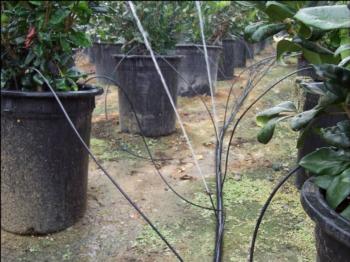 |
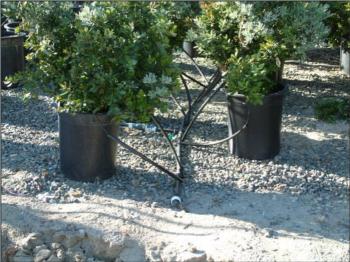 |
Rabbits can indirectly damage the crop by chewing on irrigation tubing (left). Covering tubing with duct tape or sliding flat drip lines (right) over the line will deter chewing. Dropping tubing from a raised line to keep tubing off the ground will also reduce damage to the tubing. Photos by Tracy Ellis.
UC IPM Resources
The University of California Statewide IPM Program maintains a web-based Pest Management Guideline (PMG) for floriculture and nursery production systems (http://www.ipm.ucdavis.edu/PMG/selectnewpest.floriculture.html) to be used in concert with the book Integrated Pest Management for Floriculture and Nurseries (UC ANR Publication 3402). These resources can be very helpful to growers trying to manage weeds, mollusks and vertebrates as well as arthropods and pathogens. As new products reach the market and new IPM components are developed, they will be included in the PMG.
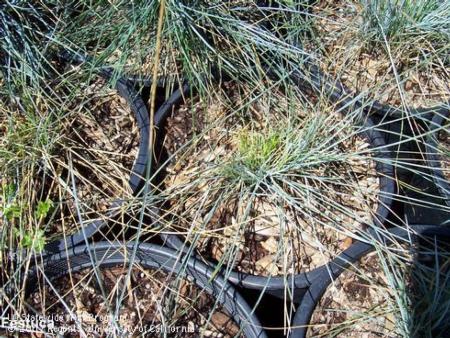
Cottontail rabbits will browse many plants species in a nursery. Three-foot tall fenc-ing will exclude cottontail rabbits. Photo by Tracy Ellis, courtesy of UC IPM.
Cheryl Wilen, Ph.D., is Area IPM Advisor, UC Statewide IPM Program and UC Cooperative Extension.












